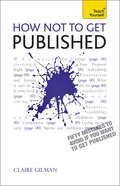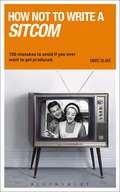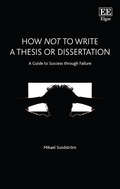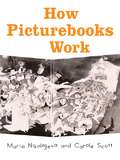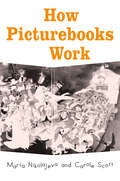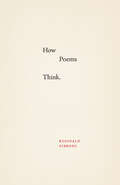- Table View
- List View
How Literatures Begin: A Global History
by Joel B. Lande Denis FeeneyA comparative history of the practices, technologies, institutions, and people that created distinct literary traditions around the world, from ancient to modern timesLiterature is such a familiar and widespread form of imaginative expression today that its existence can seem inevitable. But in fact very few languages ever developed the full-fledged literary cultures we take for granted. Challenging basic assumptions about literatures by uncovering both the distinct and common factors that led to their improbable invention, How Literatures Begin is a global, comparative history of literary origins that spans the ancient and modern world and stretches from Asia and Europe to Africa and the Americas.The book brings together a group of leading literary historians to examine the practices, technologies, institutions, and individuals that created seventeen literary traditions: Chinese, Japanese, Korean, Indian, Greek, Latin, Hebrew, Syriac, Arabic, English, Romance languages, German, Russian, Latin American, African, African American, and world literature. In these accessible accounts, which are framed by general and section introductions and a conclusion by the editors, literatures emerge as complex weaves of phenomena, unique and deeply rooted in particular times and places but also displaying surprising similarities. Again and again, new literatures arise out of old, come into being through interactions across national and linguistic borders, take inspiration from translation and cultural cross-fertilization, and provide new ways for groups to imagine themselves in relation to their moment in history.Renewing our sense of wonder for the unlikely and strange thing we call literature, How Literatures Begin offers fresh opportunities for comparison between the individual traditions that make up the rich mosaic of the world’s literatures.The book is organized in four sections, with seventeen literatures covered by individual contributors: Part I: East and South Asia: Chinese (Martin Kern), Japanese (Wiebke Denecke), Korean (Ksenia Chizhova), and Indian (Sheldon Pollock); Part II: The Mediterranean: Greek (Deborah Steiner), Latin (Joseph Farrell), Hebrew (Jacqueline Vayntrub), Syriac (Alberto Rigolio), and Arabic (Gregor Schoeler); Part III: European Vernaculars: English (Ingrid Nelson), Romance languages (Simon Gaunt), German (Joel Lande), and Russian (Michael Wachtel); Part IV: Modern Geographies: Latin American (Rolena Adorno), African (Simon Gikandi), African American (Douglas Jones), and world literature (Jane O. Newman).
How Many Languages Do We Need?: The Economics of Linguistic Diversity
by Victor Ginsburgh Shiomo WeberIn the global economy, linguistic diversity influences economic and political development as well as public policies in positive and negative ways. It leads to financial costs, communication barriers, divisions in national unity, and, in some extreme cases, conflicts and war--but it also produces benefits related to group and individual identity. What are the specific advantages and disadvantages of linguistic diversity and how does it influence social and economic progress? This book examines linguistic diversity as a global social phenomenon and considers what degree of linguistic variety might result in the greatest economic good. Victor Ginsburgh and Shlomo Weber look at linguistic proximity between groups and between languages. They describe and use simple economic, linguistic, and statistical tools to measure diversity's impact on growth, development, trade, the quality of institutions, translation issues, voting patterns in multinational competitions, and the likelihood and intensity of civil conflicts. They address the choosing of core languages in a multilingual community, such as the European Union, and argue that although too many official languages might harm cohesiveness, efficiency, and communication, reducing their number brings about alienation and disenfranchisement of groups. Demonstrating that the value and drawbacks of linguistic diversity are universal, How Many Languages Do We Need? suggests ways for designing appropriate linguistic policies for today's multilingual world.
How Many Languages Do We Need?: The Economics of Linguistic Diversity
by Victor Ginsburgh Shiomo WeberIn the global economy, linguistic diversity influences economic and political development as well as public policies in positive and negative ways. It leads to financial costs, communication barriers, divisions in national unity, and, in some extreme cases, conflicts and war--but it also produces benefits related to group and individual identity. What are the specific advantages and disadvantages of linguistic diversity and how does it influence social and economic progress? This book examines linguistic diversity as a global social phenomenon and considers what degree of linguistic variety might result in the greatest economic good. Victor Ginsburgh and Shlomo Weber look at linguistic proximity between groups and between languages. They describe and use simple economic, linguistic, and statistical tools to measure diversity's impact on growth, development, trade, the quality of institutions, translation issues, voting patterns in multinational competitions, and the likelihood and intensity of civil conflicts. They address the choosing of core languages in a multilingual community, such as the European Union, and argue that although too many official languages might harm cohesiveness, efficiency, and communication, reducing their number brings about alienation and disenfranchisement of groups. Demonstrating that the value and drawbacks of linguistic diversity are universal, How Many Languages Do We Need? suggests ways for designing appropriate linguistic policies for today's multilingual world.
How Newspapers Work: The Commonwealth and International Library: Liberal Studies Division
by W. Roy NashHow Newspapers Work is a detailed account of how newspapers work, with emphasis on the mechanics of news gathering and tasks of the reporter, sub-editor, news specialists, and editor. A typical day in the life of a morning newspaper is described, and the role of the press in society is examined. This book is comprised of seven chapters and begins with an introduction to the history of newspapers, with particular reference to some ""popular"" national daily newspapers in Britain such as the Daily Express, Daily Mail, Daily Herald, Daily Mirror, and Daily Sketch. The next chapter focuses on the role of reporters in gathering news, their education and training, and qualities of a good reporter. Subsequent chapters look at the main tasks of sub-editors, news specialists such as columnists, and editors. The penultimate chapter describes a typical day in the life of a morning newspaper, while the last chapter considers the social and political aspects of the press. This monograph will be of interest to journalists and those considering a career in the newspaper industry.
How NOT to Get Published: Fifty mistakes to avoid if you want to publish your creative writing
by Claire GillmanThere are many brilliant books out there, which have not been published because theirauthor has not been able to successfully navigate the minefield that is finding a publisher. In many cases, authors make basic mistakes in their submissions, which ensure that they do not even get read by the correct person. Even if they do reach someone with decision-making power, they often fail to clearly explain the proposition of their book, or the target market.Claire Gilman is the perfect person to help you find a publisher for your manuscript. Shehas done it successfully, having had twenty of her own books published. She has spokento many commissioning editors and agents about what they look for (and look to avoid) in a submission. And she has worked as a literary consultant, helping all sorts of authors to improve their proposals. Now, she combines all this wisdom into one book, explaining clearly 50 common mistakes which authors make, and how you can avoid them and ensure that your work receives the attention and the publisher that it deserves.
How Not to Make a Short Film: Secrets from a Sundance Programmer
by Roberta Marie MunroeAnyone can make a short film, right? Just grab some friends and your handheld and you can do it in a weekend or two before being accepted to a slew of film festivals, right? Wrong. Roberta Munroe screened short film submissions at Sundance for five years, and is an award-winning short filmmaker in her own right. So she knows a thing or two about how not to make a short film. From the first draft of your script to casting, production, editing, and distribution, this is your one-stop primer for breaking into the business. Featuring interviews with many of today's most talented writers, producers, and directors, as well as revealing stories (e.g., what to do when the skinhead crack addict next door begins screaming obscenities as soon as you call "action") from the sets of her own short films, Roberta walks you through the minefield of mistakes that an aspiring filmmaker can make--so that you don't have to make them yourself.
How Not To Write: Simple guidelines for the grammatically perplexed
by Terence DenmanHow good is your grasp of grammar? Do you write clearly and concisely - or not? Effective communication through writing - letters, emails, reports, surveys, magazines and other publications - is what many businesses depend on. But how many of us know how language works? We all tend to be a little hazy when it comes to the principles of grammar, a problem which the grammar-free schools of the last thirty years have contributed to. Despite our best intentions we often end up creating confusing, jumbled or even impenetrable writing. How Not to Write sets out the basics and destroys a few myths. Easy to read and fun to follow, you will quickly polish up your writing and communication skills and increase your confidence. Deals with everyday issues. Identifies and clarifies common myths and confusions. Takes a down-to earth approach to grammar. Contains absolutely no baffling terminology. Includes gobbledegook masterpieces from The Plain English Campaign's archives. Provides 'Rights and wrongs' and simple exercises. Written in a lively style with a light touch
How Not to Write a Novel: Confessions of a Midlist Author
by David ArmstrongEvery week, agents and publishers in this country receive hundreds of manuscripts from would-be authors. Of these, fewer than one per cent will make it into print. David Armstrong was one of the one per-centers, his first crime novel plucked from the slush pile at a major publisher and published to acclaimSo far, so good. But it rapidly became clear to Armstrong that being a published novelist is not always as glamorous as it seems from the outside. There are the depressing, ill-attended readings, the bitchy writers' conventions, the bookshops who have never heard of you and don't stock your book. All of these will be familiar to any writer who, like Armstrong, falls into to the category euphemistically known in publishing as 'midlist'. The reality is that for every JK Rowling, there are 1,000 David Armstrongs; for every writer who is put up in a five-star hotel and flies first class courtesy of their publisher, there are 1,000 who sleep on friend's floors during book tours and dine at motorway service stations...Witty, acerbic and wise, How Not to Write a Novel lifts the lid on publishing. From agents to editors, publicists to sales reps, it explains the publishing process – and how to survive it – from the point of view of a non-bestselling writer. A unique book, it is essential reading for anyone who dreams of getting their novel published – and for anyone curious about the inside workings of the publishing game.
How NOT to Write a Sitcom: 100 mistakes to avoid if you ever want to get produced (Writing Handbooks #46)
by Marc BlakeThe craft of sitcom is possibly the hardest of all screenwriting genres, demanding a complex set of skills that must all be present to succeed. How NOT to Write a Sitcom is a troubleshooting guide aimed at both the novice and the practising sitcom writer. It illustrates and explains the many pitfalls in concept, characterisation, plotting and dramatic/comedic writing,which pepper the hundreds of scripts submitted every year. Each point is illustrated with an example of the error and each section contains practical suggestions and exercises for the writer to apply to their own writing. The book takes makes no assumption of the reader other than an interest in the form. It contains interviews with current producers as well as interviews with successful practioners of the craft. Marc Blake is a script consultant, writer and teacher of writing for sitcom. In this book he acts as a `script mechanic' and offers a full `MOT for writers' - stripping a sitcom down to its component parts, isolating the faults and fixing them. What script editors and producers are looking for are scripts that work. Naturally they want a genius in embryo, but above all they first want to see something that is roadworthy.
How Not to Write a Thesis or Dissertation: A Guide to Success through Failure
by Mikael SundströmIf you thought a book about thesis writing would make for wearisome reading, think again! In seven entertaining and enlightening chapters, Mikael Sundström sheds light on the trials and tribulations of academic writing, offering guidance on how to become a doyen of academic disaster – and, more importantly, how to avoid that fate. Prepare to consider your academic writing in a whole new way. Guiding readers through the many stages of thesis writing, this dynamic book provides a comprehensive and rigorous methodology that encompasses the crucial aspects of the dreaded dissertation. It follows the writing process, from drafting the research question and composing the first line, to constructing an impressive argument and finishing a thesis with finesse. Featuring concrete tips on academic penmanship and regular ‘How Not to Fail’ boxes, Sundström identifies the potential pitfalls that lead to dissertation disaster – and expertly lays out a path to success. This useful guide will be crucial reading for postgraduate students preparing to write theses and dissertations, as well as undergraduate students undertaking longer academic papers for the first time. It will also be a convenient reference guide for course leaders in need of a bank of ideas to assist their students.
How Partisan Media Polarize America (Chicago Studies in American Politics)
by Matthew LevenduskyForty years ago, viewers who wanted to watch the news could only choose from among the major broadcast networks, all of which presented the same news without any particular point of view. Today we have a much broader array of choices, including cable channels offering a partisan take. With partisan programs gaining in popularity, some argue that they are polarizing American politics, while others counter that only a tiny portion of the population watches such programs and that their viewers tend to already hold similar beliefs. In How Partisan Media Polarize America, Matthew Levendusky confirms—but also qualifies—both of these claims. Drawing on experiments and survey data, he shows that Americans who watch partisan programming do become more certain of their beliefs and less willing to weigh the merits of opposing views or to compromise. And while only a small segment of the American population watches partisan media programs, those who do tend to be more politically engaged, and their effects on national politics are therefore far-reaching. In a time when politics seem doomed to partisan discord, How Partisan Media Polarize America offers a much-needed clarification of the role partisan media might play.
How Partisan Media Polarize America (Chicago Studies in American Politics)
by Matthew LevenduskyForty years ago, viewers who wanted to watch the news could only choose from among the major broadcast networks, all of which presented the same news without any particular point of view. Today we have a much broader array of choices, including cable channels offering a partisan take. With partisan programs gaining in popularity, some argue that they are polarizing American politics, while others counter that only a tiny portion of the population watches such programs and that their viewers tend to already hold similar beliefs. In How Partisan Media Polarize America, Matthew Levendusky confirms—but also qualifies—both of these claims. Drawing on experiments and survey data, he shows that Americans who watch partisan programming do become more certain of their beliefs and less willing to weigh the merits of opposing views or to compromise. And while only a small segment of the American population watches partisan media programs, those who do tend to be more politically engaged, and their effects on national politics are therefore far-reaching. In a time when politics seem doomed to partisan discord, How Partisan Media Polarize America offers a much-needed clarification of the role partisan media might play.
How Partisan Media Polarize America (Chicago Studies in American Politics)
by Matthew LevenduskyForty years ago, viewers who wanted to watch the news could only choose from among the major broadcast networks, all of which presented the same news without any particular point of view. Today we have a much broader array of choices, including cable channels offering a partisan take. With partisan programs gaining in popularity, some argue that they are polarizing American politics, while others counter that only a tiny portion of the population watches such programs and that their viewers tend to already hold similar beliefs. In How Partisan Media Polarize America, Matthew Levendusky confirms—but also qualifies—both of these claims. Drawing on experiments and survey data, he shows that Americans who watch partisan programming do become more certain of their beliefs and less willing to weigh the merits of opposing views or to compromise. And while only a small segment of the American population watches partisan media programs, those who do tend to be more politically engaged, and their effects on national politics are therefore far-reaching. In a time when politics seem doomed to partisan discord, How Partisan Media Polarize America offers a much-needed clarification of the role partisan media might play.
How Partisan Media Polarize America (Chicago Studies in American Politics)
by Matthew LevenduskyForty years ago, viewers who wanted to watch the news could only choose from among the major broadcast networks, all of which presented the same news without any particular point of view. Today we have a much broader array of choices, including cable channels offering a partisan take. With partisan programs gaining in popularity, some argue that they are polarizing American politics, while others counter that only a tiny portion of the population watches such programs and that their viewers tend to already hold similar beliefs. In How Partisan Media Polarize America, Matthew Levendusky confirms—but also qualifies—both of these claims. Drawing on experiments and survey data, he shows that Americans who watch partisan programming do become more certain of their beliefs and less willing to weigh the merits of opposing views or to compromise. And while only a small segment of the American population watches partisan media programs, those who do tend to be more politically engaged, and their effects on national politics are therefore far-reaching. In a time when politics seem doomed to partisan discord, How Partisan Media Polarize America offers a much-needed clarification of the role partisan media might play.
How Partisan Media Polarize America (Chicago Studies in American Politics)
by Matthew LevenduskyForty years ago, viewers who wanted to watch the news could only choose from among the major broadcast networks, all of which presented the same news without any particular point of view. Today we have a much broader array of choices, including cable channels offering a partisan take. With partisan programs gaining in popularity, some argue that they are polarizing American politics, while others counter that only a tiny portion of the population watches such programs and that their viewers tend to already hold similar beliefs. In How Partisan Media Polarize America, Matthew Levendusky confirms—but also qualifies—both of these claims. Drawing on experiments and survey data, he shows that Americans who watch partisan programming do become more certain of their beliefs and less willing to weigh the merits of opposing views or to compromise. And while only a small segment of the American population watches partisan media programs, those who do tend to be more politically engaged, and their effects on national politics are therefore far-reaching. In a time when politics seem doomed to partisan discord, How Partisan Media Polarize America offers a much-needed clarification of the role partisan media might play.
How Partisan Media Polarize America (Chicago Studies in American Politics)
by Matthew LevenduskyForty years ago, viewers who wanted to watch the news could only choose from among the major broadcast networks, all of which presented the same news without any particular point of view. Today we have a much broader array of choices, including cable channels offering a partisan take. With partisan programs gaining in popularity, some argue that they are polarizing American politics, while others counter that only a tiny portion of the population watches such programs and that their viewers tend to already hold similar beliefs. In How Partisan Media Polarize America, Matthew Levendusky confirms—but also qualifies—both of these claims. Drawing on experiments and survey data, he shows that Americans who watch partisan programming do become more certain of their beliefs and less willing to weigh the merits of opposing views or to compromise. And while only a small segment of the American population watches partisan media programs, those who do tend to be more politically engaged, and their effects on national politics are therefore far-reaching. In a time when politics seem doomed to partisan discord, How Partisan Media Polarize America offers a much-needed clarification of the role partisan media might play.
How People Talk About Politics: Brexit and Beyond
by Stephen ColemanDuring the Brexit referendum campaign it became clear how easily national conversations around politics could become raucous and bitter. This book explores the nature of talking about politically contentious issues and how our society can begin to develop a more constructive culture of political talk. Uniquely, this study focuses on citizens own experiences and reflections on developing, practising and evaluating their own political voices. Based on seventy in-depth interviews with a diverse range of people, Stephen Coleman explores the intricate nature of interpersonal political talk and what this means for public attitudes towards politics and how people negotiate their political identities. Engaging with a broad range of subjects from Political Communication to Sociology this book offers valuable insight into how the public can discuss politically turbulent topics in a meaningful and constructive way.
How People Talk About Politics: Brexit and Beyond
by Stephen ColemanDuring the Brexit referendum campaign it became clear how easily national conversations around politics could become raucous and bitter. This book explores the nature of talking about politically contentious issues and how our society can begin to develop a more constructive culture of political talk. Uniquely, this study focuses on citizens own experiences and reflections on developing, practising and evaluating their own political voices. Based on seventy in-depth interviews with a diverse range of people, Stephen Coleman explores the intricate nature of interpersonal political talk and what this means for public attitudes towards politics and how people negotiate their political identities. Engaging with a broad range of subjects from Political Communication to Sociology this book offers valuable insight into how the public can discuss politically turbulent topics in a meaningful and constructive way.
How Philosophy Became Socratic: A Study of Plato's "Protagoras," "Charmides," and "Republic"
by Laurence LampertPlato’s dialogues show Socrates at different ages, beginning when he was about nineteen and already deeply immersed in philosophy and ending with his execution five decades later. By presenting his model philosopher across a fifty-year span of his life, Plato leads his readers to wonder: does that time period correspond to the development of Socrates’ thought? In this magisterial investigation of the evolution of Socrates’ philosophy, Laurence Lampert answers in the affirmative. The chronological route that Plato maps for us, Lampert argues, reveals the enduring record of philosophy as it gradually took the form that came to dominate the life of the mind in the West. The reader accompanies Socrates as he breaks with the century-old tradition of philosophy, turns to his own path, gradually enters into a deeper understanding of nature and human nature, and discovers the successful way to transmit his wisdom to the wider world. Focusing on the final and most prominent step in that process and offering detailed textual analysis of Plato’s Protagoras, Charmides, and Republic, How Philosophy Became Socratic charts Socrates’ gradual discovery of a proper politics to shelter and advance philosophy.
How Philosophy Became Socratic: A Study of Plato's "Protagoras," "Charmides," and "Republic"
by Laurence LampertPlato’s dialogues show Socrates at different ages, beginning when he was about nineteen and already deeply immersed in philosophy and ending with his execution five decades later. By presenting his model philosopher across a fifty-year span of his life, Plato leads his readers to wonder: does that time period correspond to the development of Socrates’ thought? In this magisterial investigation of the evolution of Socrates’ philosophy, Laurence Lampert answers in the affirmative. The chronological route that Plato maps for us, Lampert argues, reveals the enduring record of philosophy as it gradually took the form that came to dominate the life of the mind in the West. The reader accompanies Socrates as he breaks with the century-old tradition of philosophy, turns to his own path, gradually enters into a deeper understanding of nature and human nature, and discovers the successful way to transmit his wisdom to the wider world. Focusing on the final and most prominent step in that process and offering detailed textual analysis of Plato’s Protagoras, Charmides, and Republic, How Philosophy Became Socratic charts Socrates’ gradual discovery of a proper politics to shelter and advance philosophy.
How Philosophy Became Socratic: A Study of Plato's "Protagoras," "Charmides," and "Republic"
by Laurence LampertPlato’s dialogues show Socrates at different ages, beginning when he was about nineteen and already deeply immersed in philosophy and ending with his execution five decades later. By presenting his model philosopher across a fifty-year span of his life, Plato leads his readers to wonder: does that time period correspond to the development of Socrates’ thought? In this magisterial investigation of the evolution of Socrates’ philosophy, Laurence Lampert answers in the affirmative. The chronological route that Plato maps for us, Lampert argues, reveals the enduring record of philosophy as it gradually took the form that came to dominate the life of the mind in the West. The reader accompanies Socrates as he breaks with the century-old tradition of philosophy, turns to his own path, gradually enters into a deeper understanding of nature and human nature, and discovers the successful way to transmit his wisdom to the wider world. Focusing on the final and most prominent step in that process and offering detailed textual analysis of Plato’s Protagoras, Charmides, and Republic, How Philosophy Became Socratic charts Socrates’ gradual discovery of a proper politics to shelter and advance philosophy.
How Picturebooks Work (Children's Literature and Culture)
by Maria Nikolajeva Carole ScottHow Picturebooks Work is an innovative and engaging look at the interplay between text and image in picturebooks. The authors explore picturebooks as a specific medium or genre in literature and culture, one that prepares children for other media of communication, and they argue that picturebooks may be the most influential media of all in the socialization and representation of children. Spanning an international range of children's books, this book examine such favorites as Curious George and Frog and Toad Are Friends, along with the works of authors and illustrators including Maurice Sendak and Tove Jansson, among others. With 116 illustrations, How Picturebooks Work offers the student of children's literature a new methodology, new theories, and a new set of critical tools for examining the picturebook form.
How Picturebooks Work (Children's Literature and Culture #14)
by Maria Nikolajeva Carole ScottHow Picturebooks Work is an innovative and engaging look at the interplay between text and image in picturebooks. The authors explore picturebooks as a specific medium or genre in literature and culture, one that prepares children for other media of communication, and they argue that picturebooks may be the most influential media of all in the socialization and representation of children. Spanning an international range of children's books, this book examine such favorites as Curious George and Frog and Toad Are Friends, along with the works of authors and illustrators including Maurice Sendak and Tove Jansson, among others. With 116 illustrations, How Picturebooks Work offers the student of children's literature a new methodology, new theories, and a new set of critical tools for examining the picturebook form.
How Poems Think
by Reginald GibbonsTo write or read a poem is often to think in distinctively poetic ways—guided by metaphors, sound, rhythms, associative movement, and more. Poetry’s stance toward language creates a particular intelligence of thought and feeling, a compressed articulation that expands inner experience, imagining with words what cannot always be imagined without them. Through translation, poetry has diversified poetic traditions, and some of poetry’s ways of thinking begin in the ancient world and remain potent even now. In How Poems Think, Reginald Gibbons presents a rich gallery of poetic inventiveness and continuity drawn from a wide range of poets—Sappho, Pindar, Shakespeare, Keats, William Carlos Williams, Marina Tsvetaeva, Gwendolyn Brooks, and many others. Gibbons explores poetic temperament, rhyme, metonymy, etymology, and other elements of poetry as modes of thinking and feeling. In celebration and homage, Gibbons attunes us to the possibilities of poetic thinking.
How Poems Think
by Reginald GibbonsTo write or read a poem is often to think in distinctively poetic ways—guided by metaphors, sound, rhythms, associative movement, and more. Poetry’s stance toward language creates a particular intelligence of thought and feeling, a compressed articulation that expands inner experience, imagining with words what cannot always be imagined without them. Through translation, poetry has diversified poetic traditions, and some of poetry’s ways of thinking begin in the ancient world and remain potent even now. In How Poems Think, Reginald Gibbons presents a rich gallery of poetic inventiveness and continuity drawn from a wide range of poets—Sappho, Pindar, Shakespeare, Keats, William Carlos Williams, Marina Tsvetaeva, Gwendolyn Brooks, and many others. Gibbons explores poetic temperament, rhyme, metonymy, etymology, and other elements of poetry as modes of thinking and feeling. In celebration and homage, Gibbons attunes us to the possibilities of poetic thinking.



